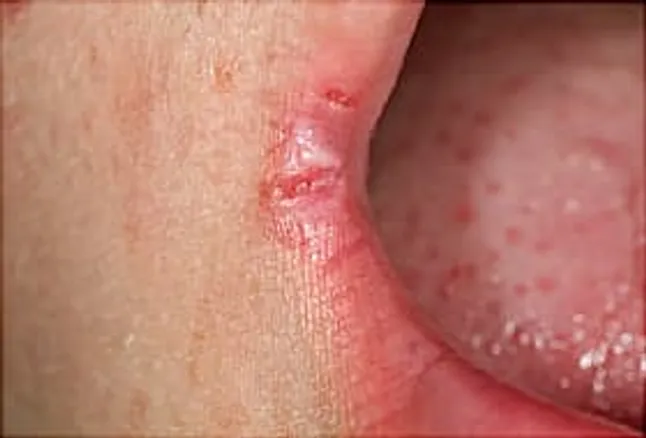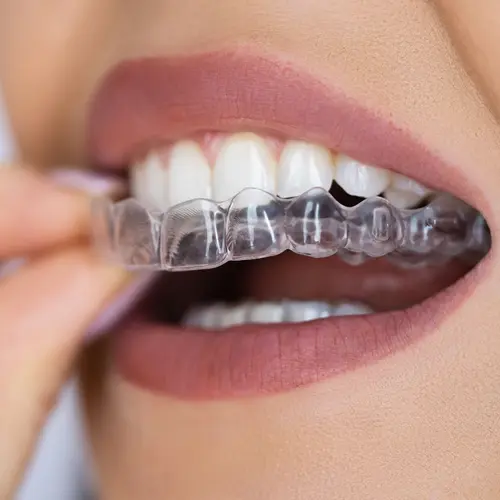Angular cheilitis is a condition that causes red, swollen patches in the corners of your mouth where your lips meet and make an angle. Other names for it are perleche and angular stomatitis. You can get it on one side of your mouth or on both sides at the same time.
“What we call angular cheilitis is usually irritation or a yeast infection at the corners of the mouth from collection of fluid in the fold from drooling, skin laxity, oral hardware, or antibiotics,” says Dina D. Strachan MD, a board-certified dermatologist whose practice, Aglow Dermatology, is located in New York.
Angular Cheilitis Symptoms
The main symptoms of angular cheilitis are irritation and soreness in the corner(s) of your mouth. One or both corners may be:
- Bleeding
- Blistered
- Cracked
- Crusty
- Itchy
- Painful
- Red
- Scaly
- Swollen

Your lips can feel dry and uncomfortable. Sometimes your lips and mouth can feel like they’re burning. You also might have a bad taste in your mouth.
If the irritation is strong, it can make it hard for you to eat. You may not get enough nutrients or you may lose weight.
Angular Cheilitis Causes, Diagnosis, Treatment
This condition causes red, swollen patches in the corners of your mouth. Learn more about who’s at risk and what treatments may help.
Saliva gets trapped and builds up in the corners of your mouth. When it dries, the skin in the area can crack. You may lick your lips often to soothe your cracked skin. The warmth and moisture in the corners of your mouth create the perfect conditions for fungus to grow and multiply — and cause infection.
Fungal infection is the most common cause of angular cheilitis. It’s usually caused by a type of yeast called candida — the same fungus that causes diaper rash in babies. Certain bacteria strains also can cause it.
A deficiency in riboflavin (vitamin B2) may also lead to angular cheilitis.
If your doctor can’t find the cause, it’s called idiopathic angular cheilitis.
Why Do I Keep Getting Angular Cheilitis?
You’re more likely to get angular cheilitis if the corners of your mouth are moist a lot of the time. This might happen for many reasons, such as:
- You have braces.
- You wear dentures that don’t fit well.
- You lick your lips a lot.
- You have a lot of saliva.
- Your teeth are crooked, or your bite isn’t lined up correctly.
- You have sagging skin around your mouth from weight loss or age.
- You suck your thumb.
- You smoke.
- You don’t get enough nutrients, such as vitamin B or iron.
Certain medical conditions can put you at a higher risk, such as:
- Anemia
- Cancers of the blood
- Diabetes
- Down syndrome
- Immune disorders, such as HIV
- Kidney, liver, lung, or pancreatic cancer
Angular Cheilitis and Diabetes
It’s common for people with diabetes to get fungal infections such as angular cheilitis. This is because fungi like candida feed off glucose -- the blood sugar your body uses as a source of energy. If you have diabetes, you have too much glucose in your blood.
Extra glucose can create a breeding ground for fungus. Diabetes also weakens your immune system, which makes it harder for you to fight off infection.
You can help prevent conditions such as angular cheilitis by keeping your blood glucose levels in check. Eat well, exercise, and take your insulin correctly. It’s also important not to smoke.
Angular Cheilitis Diagnosis
Your doctor will examine your mouth closely to look at any cracks, redness, swelling, or blisters. They’ll also ask you about habits you might have that could affect your lips.
Other conditions (such as herpes labialis and erosive lichen planus) can cause symptoms similar to angular cheilitis. To be sure of the cause, your doctor might swab the corners of your mouth and nose and send it to a lab to see what kinds of bacteria or fungi might be there.
Angular Cheilitis Self-Care
Angular cheilitis home remedies include:
- Frequently applying lip balm or petroleum jelly. This can treat angular cheilitis caused by saliva buildup.
- Staying hydrated.
- Applying extra virgin olive oil. A team of Italian dentists found the longtime cultural home remedy was effective as an alternative therapy to drugs.
Be sure to check in with your doctor if your symptoms don’t improve or get worse.
Angular Cheilitis Treatment
“If angular cheilitis is just caused by dry, inflamed skin, a petrolatum ointment can help resolve it,” Strachan says. This protects your mouth from moisture so the sores can heal. If your case relates to eczema, “a topical steroid, such as over-the-counter hydrocortisone 1% ointment, can do the job.”
“If there is concern of infection, clotrimazole or another antifungal may be needed (to treat) yeast,” she says. Herpes and bacterial infections may require prescriptions.
How long does angular cheilitis last?
After you start angular cheilitis treatment, it usually goes away in a couple of weeks. However, it can come back even after successful treatment.
Angular cheilitis medication
Antifungal creams include:
- Clotrimazole (Lotrimin)
- Ketoconazole (Extina)
- Miconazole (Lotrimin AF, Micatin, Monistat Derm)
- Nystatin (Mycostatin)
Antibacterial drugs include:
- Mupirocin (Bactroban)
- Fusidic acid (Fucidin, Fucithalmic)
How to Prevent Angular Cheilitis
You can’t always avoid getting angular cheilitis, but you can cut down your chances if you:
- Don’t lick your lips.
- Eat healthy foods and drink lots of water.
- Use lip moisturizers. “Keep the area moisturized, but don’t allow saliva to accumulate,” Strachan says.
- Don’t use expired makeup.
- Don’t smoke or use tobacco.
- Consider suppressive antiviral treatment.
Strachan notes that you can take this type of treatment, “If you’re prone to certain infections, such as cold sores, in the area.”
Takeaways
Angular cheilitis is the name for red, swollen patches in the corners of one or both sides of your mouth.
The most common cause is a fungal infection resulting from the buildup of saliva. Another is vitamin B2 deficiency.
Depending on the cause, it can be treated with petrolatum ointment, antifungal cream, or an antibacterial medication. It usually resolves
within a couple of weeks but can return.
Angular Cheilitis FAQs
Is angular cheilitis contagious?
No, not unless it’s caused by herpes simplex. Unlike cold sores, causes of angular cheilitis are usually limited to conditions that happen in your own body.
What are the stages of angular cheilitis?
You might first notice red swollen areas on the edges of your mouth and lips. A mild case might start with pinkish patches at the corners of your mouth, and sometimes lip chapping. In skin of color, the areas might look lighter and have darker borders. Moisture can then wear away the top layer of skin and cause deeper lesions. Moderate cases can involve cracks in your skin. A very severe case might cause skin cracks to deepen into splits that can bleed, but it doesn’t usually happen.
What is the best over-the-counter antifungal for angular cheilitis?
Many doctors recommend miconazole (Monistat) or clotrimazole (Lotrimin) for angular cheilitis treatment.
Is Acyclovir good for angular cheilitis?
Acyclovir is an antiviral drug most commonly used to treat infections caused by the herpes simplex virus. Angular cheilitis is typically treated with petrolatum ointment or antibacterial or antifungal meds.




